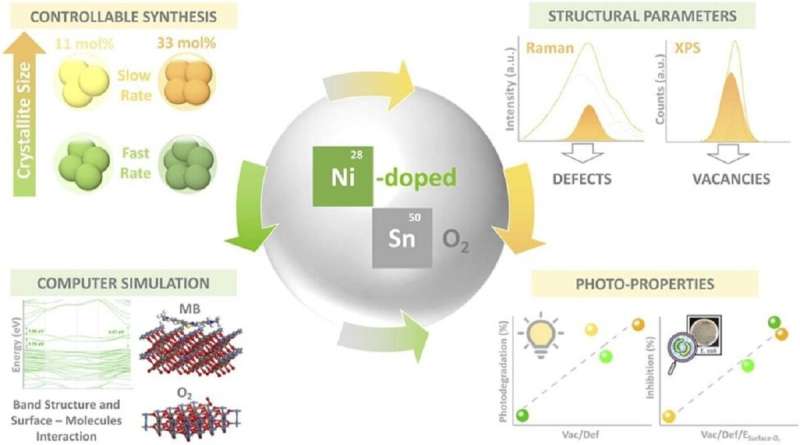This article has been reviewed according to Science X's editorial process and policies. Editors have highlighted the following attributes while ensuring the content's credibility:
fact-checked
peer-reviewed publication
trusted source
proofread
Chemical navigation: Scientists develop a water remediation method using nanoparticles

Chemists from St Petersburg University have developed a method for purifying water from organic compounds using tin oxide nanoparticle based photocatalysts. The findings of the research are published in the Journal of Alloys and Compounds .
Water pollution is an acute environmental issue. Due to the high rate of industrial development and increasing volumes of wastewater, the ecology of water bodies is deteriorating. Scientists are therefore working hard to develop new ways of treating industrial discharges that would quickly and without unnecessary waste purify water from complex pollutants such as organic dyes.
One of the most promising approaches in wastewater treatment technology to purify water is to use photocatalysis. It is a process in which light energy is used to trigger chemical reactions to break down organic compounds into carbon dioxide and water through the presence of a catalyst—a special material in the form of nanoparticles. Until now, there has been no understanding of what exactly determines the efficiency and speed of such purification: the size of the particles, the features of their structure or their composition. The researchers from St Petersburg University have found the answer to this question.
The chemists from St Petersburg University proposed a systematic approach to matching a particular pollutant with nanoparticles for use in photocatalytic water purification units. The materials developed exhibit photocatalytic activity when exposed to visible light from ordinary diode lamps, which in all respects are cheaper and easier to operate than the ultraviolet ones used previously.
"We offer a fundamentally new approach, which can be compared to a road navigation system. For example, you can use an ordinary paper map when choosing a route to your destination, plotting your route yourself in real time, guided by road signs and the situation.
"We propose an algorithm similar to modern navigation systems which, for any desired destination, process several route options, analyze the current traffic situation and select the shortest route. Whereas previously the materials for photocatalysts were chosen almost at random, today this process is becoming thoughtful and well-founded," said Anastasiia Podurets, principal investigator of the project and an early career researcher in the Department of General and Inorganic Chemistry at St Petersburg University.
Nanoparticles based on tin dioxide containing three elements (cobalt, nickel, copper) were used. The research team of synthesis and research of nanoparticles and nanostructured materials carried out a large-scale study of nanoparticles formation processes and products of photocatalytic decomposition of pollutants under different conditions.
The scientists have found out that in order to create an effective catalyst, it is necessary to organize its synthesis in such a way that a solid body with the maximum number of oxygen vacancies—lattice defects when there are no individual atoms in it—is formed. It is the vacancies that allow the emerging electron-hole pairs to be transferred to the surface of nanoparticles, where they play a major role in the destruction of pollutant molecules. It is important not to have too many other defects, otherwise the result will be the opposite. The approach developed has been proven with the widely used organic dye methylene blue and the antibiotic oxytetracycline.
Studies on water remediation methods using nanoparticles have also been published in the journals Materials Chemistry and Physics and Journal of Hazardous Materials.
In addition to photocatalysis, the scientists demonstrated the antibacterial activity of the synthesized nanoparticles using E. coli bacteria. As the mechanisms of destruction of organic molecules are similar to those used for neutralizing bacteria, effective photocatalysts are also capable of destroying the corresponding bacteria.
The researchers say that this method is also applicable to other pollutants: Special calculations are needed to understand how to change the parameters of nanoparticles against different pollutants.
More information: Anastasiia Podurets et al, Experimental and computational study of Ni-doped SnO2 as a photocatalyst and antibacterial agent for water remediation: The way for a rational design, Journal of Alloys and Compounds (2022). DOI: 10.1016/j.jallcom.2022.166950
Journal information: Journal of Hazardous Materials
Provided by St. Petersburg State University




















